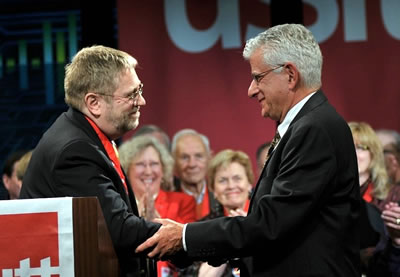 |  |  | |
 | Steve Terry, left, offers his best wishes to Gordon Pearlman on Wednesday, March 31. USITT Fellows are elected to the honor, and the names of recipients is not revealed until the induction ceremony as part of the Annual Conference. Photo/R. Finkelstein | |
| Pearlman Named Fellow Over the last 35 years, Gordon Pearlman has been one of the most prolific architect-designers of lighting control systems in the United States. After getting his MFA from Tulane and working at the University of North Carolina Greensboro and Chapel Hill as a teacher, technical director, and designer, Gordon's control system design career began 1975 with the LS-8, the first computerized lighting control system used on Broadway on the original production of A Chorus Line, with lighting design by the late Tharon Musser. This control system radically changed the way the Broadway theatre operates, and within three years after A Chorus Line, virtually every production had moved to computer lighting control after being in the dark ages of resistance boards for decades. Mr. Pearlman, along with his partner Steve Carlson, went on to design a series of watershed control systems, perhaps the most notable being the Kliegl Performer. Introduced in 1981, this table-top system moved both the size and price point of computer lighting control to a level that made it available to the masses. Previous computer control systems cost between $75,000 and $150,000, and were relegated to permanent installations that could support that kind of tariff. The Performer sold for $15,000 and was immediately purchased by rental companies all over the United States because of its capabilities, portability, and price point. This meant that off-Broadway and touring productions immediately began to use computer control -- and they never went back. The next Pearlman milestone was in 1989, the Access console for GAM -- a device with a list price of just $2,495 and considerably more capability than the original LS-8 that cost 20 times that amount. It is hard to describe the shock effect that such pricing had on the market. These Pearlman milestones had the profound effect of moving computer control to every corner of the performing arts and enabled lighting designers to work more creatively, free of the previous restrictions of manual control systems. While other control systems came out of other manufacturers in the market, Pearlman reset the bar in increasing features and reducing cost by an order-of-magnitude with every product, with the associated increase in accessibility to the design community. Often, this drove other manufacturers to follow his lead. His contribution in this area simply cannot be overstated. Mr. Pearlman also played a key role in the development of the DMX512 Standard, a true USITT success story. At the original DMX512 meeting in 1986, Gordon actually showed up with a draft of the framework of the standard written down. That allowed the assembled manufacturers to get comfortable with the idea of a new standard because they could actually see what it would look like via Gordon's draft. Without that piece of paper, the DMX512 discussion might have gone on for months or years without producing the standard that has brought hundreds of millions -- I repeat, hundreds of millions -- of dollars into our industry over the last 24 years. Interestingly, the DMX512 standard as published did not deviate much from Gordon's draft! Please join me now in congratulating our friend, colleague, and USITT fellow, Gordon Pearlman. Gordon Pearlman was one of three new Fellows to be inducted in a ceremony at the 2010 Annual Conference in Kansas City, Missouri. This honorary designation is given to those selected by vote of the current Fellows and is bestowed for life upon those members who have made a truly outstanding contribution to the theatre and the work of the Institute. Click their names to read the introductory remarks about the other new Fellows, Reid Neslage and Ursula Belden. | ||